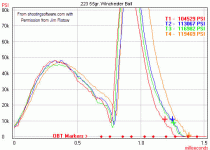Those powders are too slow for a bullet that light. That's why you don't see data. When a bullet is too light for the powder, it runs away from the case so fast a slow powder can't make gas fast enough to keep up with it. The result, at best, is disappointing velocity and a lot of powder being thrown out of the muzzle unburned. The powders you mention really work best with 69 grain match bullets and heavier, IME.
The worst case scenario is that a funny secondary pressure can develop when bullets are too light for the powder burn rate. Gas columns in barrels don't make a uniformly distributed pressure, and drops a bit behind the bullet. If the bullet is there long enough, the higher pressure zone throws a pressure front up against it that reflects up and down the bore and it can double up making additive pressure very high as the zones pass through each other. Normally, this is an artillery issue, as in small arms as the barrel time is typically shorter than the resonant frequency of the waves. However, when a bullet scoots away from a powder too fast, it is possible for pressure at its base to drop an unusual amount, letting the bullet slow down, thereby lengthening barrel time enough for a pressure wave of gas to create the high pressure nodal additive condition. Texas gunsmith Charlie Sisk has blown muzzles off 338's with a particularly bad combination. It can take a dozen shots, but the barrel bulges down near the muzzle and it happens at a consistent location, so it finally bulges enough to develop cracks and lets go.
This is not always happening, but you have to be aware it can occur when you start messing with inappropriate powder burn rates. I would recommend you look at Reloader 10X, which is made specifically for light bullet use.
Even commercial loaders can mess up sometimes:


